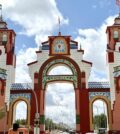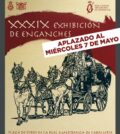- La gran ampliación de la Feria de Abril de Sevilla se retrasa a 2028 y superará los 80 millones de euros
- El Gran Circo Mundial vuelve a la Feria de Sevilla 2025
- Aplazada la XXXIX Exhibición de enganches al miércoles 7 de mayo
- Servicio especial autobuses urbanos (TUSSAM) durante la Feria de Sevilla
- Novedades Feria de Abril de Sevilla 2025
- Paradas de taxi en la Feria de Abril de Sevilla 2025
- Días sin ruido en la Calle del Infierno. Feria de Sevilla
- Sevilla Este contará por primera vez con una línea de TUSSAM directa a la Feria de Abril de Sevilla
- Aparcamientos Feria de Abril de Sevilla 2025
- Caseta Hospital en la Feria de Abril de Sevilla
Historia de los Trajes de Flamenca
 Su origen lo encontramos en la primitiva feria de ganado. A ella acudían las mujeres de los tratantes, en un buen número gitanas y campesinas andaluzas. Sus ropas eran humildes batas de percal. Esas batas de trajinar, rematadas en dos o tres volantes constituyeron con el paso de los años una auténtica moda. Las claves estaban claras, este atuendo realzaba el cuerpo de la mujer y además le imprimía un garbo que no se lograba con las ropas que llegaban del exterior.
Su origen lo encontramos en la primitiva feria de ganado. A ella acudían las mujeres de los tratantes, en un buen número gitanas y campesinas andaluzas. Sus ropas eran humildes batas de percal. Esas batas de trajinar, rematadas en dos o tres volantes constituyeron con el paso de los años una auténtica moda. Las claves estaban claras, este atuendo realzaba el cuerpo de la mujer y además le imprimía un garbo que no se lograba con las ropas que llegaban del exterior.
Un fenómeno a tener muy en cuenta fue el cómo las clases acomodadas copiaban en sus atuendos a las más humildes. Empezaba la revolución…
El traje de flamenca ha ido evolucionando con los años. Así la tosquedad de las primeras telas fue vencida con la profusión de volantes, que imprimían al andar un aire más jacarandoso. Las características se decantaron claramente con el paso del tiempo: escote de pico, redondo o cuadrado, pelo recogido en moño, telle ceñido que se abre en las caderas a modo de flor y los importantísimos complementos: flores en el pelo, collares, pendientes, mantones de Manila…
La Exposición de Sevilla de 1929 sirvió como consagración del traje de flamenca y la aceptación por parte de las clases pudientes como atuendo indispensable para acudir a la Feria.
EL SOMBRERO DE A LA ANCHA Y EL TRAJE CORTO
La Feria de Abril no podría imaginarse sin un caballista de corto y sin un sombrero de ala ancha. Realmente este atuenda era antaño un traje de faena. El traje corto era el de faena en el campo y con el que acudían a las ferias de ganado, a entablar relaciones comerciales con tratantes, vendedores y compradores. Mientra tanto, el sombrero era una prenda que se usaba habitualmente en la época.
El traje corto de amazona es una derivación del masculino. Sevilla es la ciudad de las formas y el tema de la indumentaria para montar a caballo no podía ser menos. Así el gremio de Maestros Sastres de Sevilla elaboró «El decálogo del sí», donde se recoge con precisión y escuetamente las normas para utilizar el traje corto: Sí a los colores sobrios, grises y marrones, que aguanten el polvo. Lisos o de pequeños dibujos como espiguilla, ojo de perdiz, pata de gallo, etc. Sí al color del sombrero haciendo juego con el traje o, en todo caso con la chaquetilla. Espuelas, tirantes, chaleco y pañuelo a faja. El pantalón de vuelta blanca, con botón enterizo, y el de caireles, con botín y polaina».
 También nos podemos encontrar con el «decálogo del no», ahí figura lo que nunca debe ser utilizado: «No a la corbata, a la bufanda, a los guantes, al cinturón y al reloj de muñeca, mejor sin barba ni cabellos largos, ni coleta, ni gafas de sol. No a la camisa con chorreras o al pantalón con la raya planchada. No a la ropa negra o de colores chillones. En la feria, no al catavino o a las medallas colgando. Eso cabe en la romería. No a los zahones y a las espuelas pie a tierra.
También nos podemos encontrar con el «decálogo del no», ahí figura lo que nunca debe ser utilizado: «No a la corbata, a la bufanda, a los guantes, al cinturón y al reloj de muñeca, mejor sin barba ni cabellos largos, ni coleta, ni gafas de sol. No a la camisa con chorreras o al pantalón con la raya planchada. No a la ropa negra o de colores chillones. En la feria, no al catavino o a las medallas colgando. Eso cabe en la romería. No a los zahones y a las espuelas pie a tierra.
LOS BUÑUELOS
El Diccionario de la Real Academia española de la Lengua define al buñuelo como «fruta de sartén que se hace de masa de harina bien batida y frita en aceite. Cuando se fríe se esponja y sale de varias figuras y tamaños». Son los gitanos los encargados de mantener esta tradición viva en el Real de la Feria. Su receta está celosamente guardada. Lo único seguro es que cuando acaba la madrugada hay un lugar de visita obligada en la Feria de Abril, es el llamado «patio de los gitanos». La limpieza y calidad de sus productos salta a la vista y ademá es toda una tradición en la ciudad de la Giralda.















